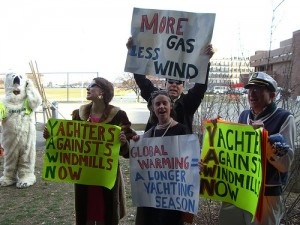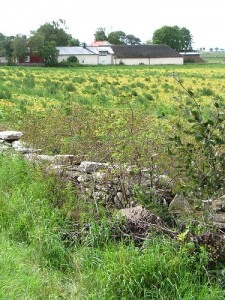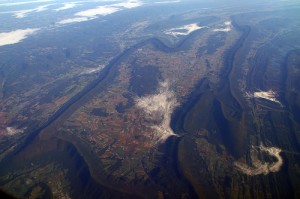Get your wind farm off my historic site: When visions of sustainability collide (Part 2)
10 February 2014 – Steven Burg

Large-scale wind-power developments often provoke strong pro and con feelings, as this 2008 band of satirical Cape Wind counter-protesters in Massachusetts shows. Photo credit: Phil LaCombe.
Continued from Part 1.
The case of Southern Öland provides a rather dramatic case where visions of heritage preservation and renewable energy development collided, but it is certainly not unique. Other communities have faced similar challenges, including the World Heritage sites of Mont-Saint-Michel in France (where an off-shore wind project was blocked by the French courts), and Britain’s Jurassic Coast. In the United States, the Cape Wind project proposed for Nantucket Bay off of Martha’s Vineyard has generated a fierce legal and political struggle that has spanned more than a dozen years. Cape Wind’s Construction and Operation plans received approval from the US Department of the Interior’s Bureau of Ocean Energy Management, Regulation and Enforcement in 2011 despite a determination by the Advisory Council on Historic Preservation that the wind farm would negatively affect thirty-six historic sites and districts, and six resources of cultural and religious significance to the region’s Indian tribes.
The many compelling arguments in favor of renewable energy projects makes opposing them challenging. Renewable energy is widely viewed as an environmentally friendly source of power that enables the comfortable standard of living to which modern societies have grown accustomed and supports energy independence without the toxicity of fossil fuels. Wind turbines and solar panels also allow nations to continue generating energy while reducing carbon emissions, something particularly important for nations such as Sweden that are signatories to the 2005 Kyoto Protocol, and that also must comply with the European Union’s nation-specific targets for reducing carbon emissions set in 2007 (targets that are now being reconsidered as a result of the economic downturn). Commentators such as Thomas Friedman have also argued that a failure to embrace clean and renewable energy strengthens authoritarian, oil-rich regimes.
When such policies are embraced by powerful political leaders and multinational energy corporations, the rhetorical, financial, and political power behind such initiatives can be considerable. Advocating for the protection of cultural resources when the alternative is framed as ensuring national security, protecting the environment, and safeguarding the future of the planet is certainly a daunting challenge.
So how should historic preservationists respond to these threats to cultural resources, particularly when preservationists themselves may favor the development of renewable energy resources? Is there a way to reconcile the competing demands of cultural heritage preservation and renewable energy development?
Yes, but it will require even greater levels of political engagement, particularly at the earliest stages of project development. As Richard Wagner, director of Goucher College’s historic preservation program, has noted, preservationists need to gain a seat at the table. They need to play a role when sustainable energy plans and legislation are drafted at all levels of government. In the case of wind and solar projects, they need to advocate for cultural and historical resources when developers are considering sites for prospective projects. They need to work with environmental organizations and other stakeholders to educate local planning offices, elected officials, energy companies, and developers about the value of cultural and historic resources, and to build an ongoing consensus that projects should be developed at a scale, and in locations, that are compatible with protecting cultural and natural resources. Everyone at the table needs to believe that there are some sites that are simply too precious to compromise, even in pursuit of renewable energy.

Öland’s historic agricultural landscape may have value in sustainability discourses, just as renewable energy generation does. Photo credit: Kevin Burden.
Historic preservation advocates also need to muster strong arguments in defense of the preservation ethic. These arguments need to be based on aesthetics and economic arguments, as well as the value of preserving communities’ sense of place. However, historic preservation advocates need to clearly articulate the value of historic preservation in building a sustainable society. For historic structures, such arguments may focus on the legacy investment of money, energy, and natural resources in existing structures; the potential for historic structures to provide affordable housing; or the way that restoration projects can create jobs for local businesses and craftsmen. Historic landscapes, especially those of pre-industrial agricultural societies, must also be viewed as precious cultural resources that can be studied to reveal lessons about sustainable land use techniques, construction methods, technologies, and patterns of social organization that might be worth emulating or adapting to contemporary societies.
Historic preservationists also need to demonstrate that all renewable energy projects are not created equal. Some can be constructed with minimal impact on a region’s environment or quality of life. However, large-scale industrial wind turbine projects require significant amounts of clearing, blasting, and leveling to create turbine pads, access roads, and power lines. They also have the potential to create noise and traffic that can dramatically alter a region’s ecosystem and soundscape. Such projects can often be driven less by concern for the environment than by the promise of profits to be reaped by large-scale projects underwritten with generous public subsidies. The rush by energy corporations to capitalize on government economic incentives without full consideration of the impact that renewable energy projects can have on communities, cultural, and natural resources has led groups in North America and Europe to aggressively oppose wind farms and to even pursue local moratoriums on wind development.
In the absence of good policy and process, preservationists and communities must identify the sites of greatest value for protection and work to mitigate the impact of renewable energy development at other locations. When projects are underway that threaten significant cultural resources, preservation coalitions must decide if they will take steps to stop a project. Such fights are hard, but on occasion, they can be won.

People from the working agricultural landscape around Evitts Mountain, Pennsylvania, sought historic designation as part of their fight to stop a large-scale wind farm. Photo credit: Doc Searls.
One example is the case of Dutch Corner in rural Bedford County, Pennsylvania. A large wind farm project slated for Evitts Mountain threatened to undermine a historic landscape encompassing more than 30 historic farms and related buildings, leading to the site’s listing on Preservation Pennsylvania’s 2010 “Pennsylvania at Risk” list. By building a coalition of local and national organizations, creating a National Register Historic District, winning passage of a strong local preservation ordinance, and blocking efforts to weaken the ordinance and shrink the historic district’s boundaries, community members mounted a vigorous campaign to stop the project.
Yet the factor that ultimately stopped the wind farm, according to Iberdrola Renewables spokesman Paul Copleman quoted in the Pittsburgh Post-Gazette, was the end of federal tax credits for renewable energy projects at the end of 2013. The site was saved, but it is hard to know what the outcome might have been if federal tax policy had not changed.
Ultimately, the best way to advance a vision of a sustainable society that values clean energy development and the protection of cultural resources is to establish public policies at the local, state, national, and international levels that recognize the value of both and establish frameworks for how they might best be balanced in decision-making. This is a matter of public education but, more significantly, a matter of political advocacy. Political leaders responsible for policy making need to recognize that heritage preservation does not need to be viewed only as an obstacle to energy development initiatives but rather as a complementary and essential component of a sustainable society.
~ Steven Burg is Professor of History & Chair of the History and Philosophy Department at Shippensburg University of Pennsylvania. In the fall of 2013, he received a Fulbright Scholar’s grant to study approaches to historic preservation and public history in the Kingdom of Sweden.




Thank you SO much for this entry Steve. I have been fascinated by the issues and problems that Cape Wind raises. This issue of renewables and preservation being on odds deserves so much more exploring and need for reconciliation. And as you point out, it is hardly an isolated incident. I hope we can continue to think and attempt to reconcile some of these tensions.
Chesapeake Bay’s Somerset County, currently under assault by Pioneer Green Energy, is an example of poor site selection jeopardizing our rich cultural heritage. Sites are chosen based on available transmission and federal tax money, after which point developers seek to shove their poorly sited (square peg) projects into areas where they do not fit – round holes. It is not just disappointing but is disgusting to see the lack of respect, reverence and responsibility so many feel toward others and the planet when there is a buck to be made.